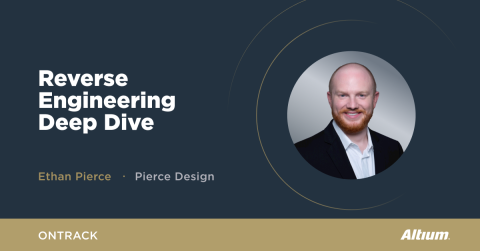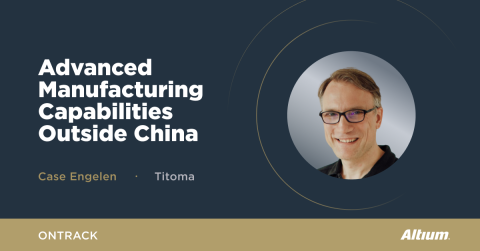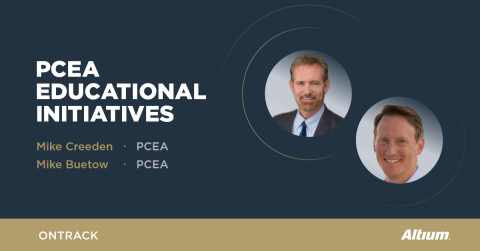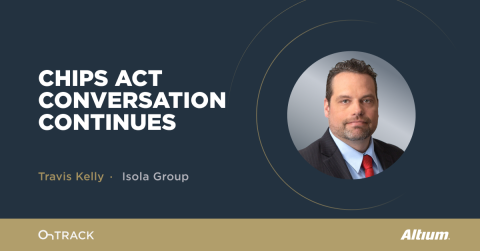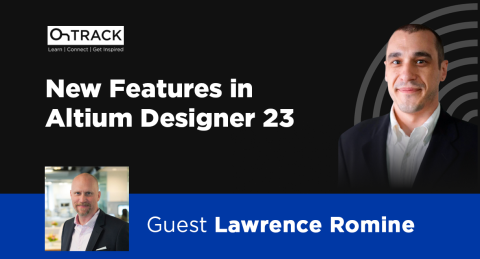IPC Courses, PCB Design Practices & Advanced Materials with Kris Moyer

Join Tech Consultant Zach Peterson in this interview with Kris Moyer, an esteemed IPC instructor and seasoned PCB design expert. They pair cover a wide range of topics including IPC courses, PCB design practices, and advanced materials.
Discover how IPC courses can elevate your PCB design skills, learn about best practices in high-speed digital design (as well as a few other types of design), and explore the challenges of working with advanced materials in the PCB industry.
Listen to the Episode:
Watch the Episode:
Key Topics:
- The importance of IPC courses for PCB designers
- Best practices in PCB design and signal integrity
- Overcoming challenges with high-speed digital design
- Understanding and utilizing advanced materials in PCB manufacturing
- Kris Moyer's career journey and industry insights
Links:
Connect with Kris Moyer here
Transcript:
Zach: How are IPC courses different from other courses that you might find out in the wild, such as courses in colleges?
Kris: Right. So actually my course is modeled off of a course I created for my university up here, and they are effectively the equivalent of what you do in a college. They are live online instructor-led, and they are interactive courses.
-Zach: Hello, everyone. Welcome to the all TM OnTrack podcast. I'm your host, Zach Peterson. Today, we're talking with Kris Moyer. You may know Kris Moyer as an IPC instructor. You may also know him as someone who is published somewhat often in iConnect. I'm very happy to talk with Kris today, and we'll be talking about high speed digital designs and high frequency designs. Kris, thank you so much for joining us today.
Kris: Excellent. Welcome and thank you for having me on the podcast, Zach. I've seen several of yours in the past on the Altium page, so excellent. Thank you for having me.
Zach: Awesome, awesome. That means we're doing something right. If you could, please just tell us a bit about your background and how you got into the PCB industry.
Kris: Yeah, so I've been in the PCB design industry as an electrical engineer for a little over 30 years now. I actually got into the PCB design side of things as kind of a fluke. One of my very first jobs... I grew up outside of Detroit, Michigan. So one of my first jobs back in Michigan where I grew up, started as a like engineering technician, junior engineer. And shortly after I joined there, the company decided, "You know, we're no longer gonna outsource our print circuit board design, you're gonna start designing boards." And so the bosses just came and said, "Go bring all three," at the time, three main CAD tools, "in, figure out which one you like. We'll buy you a license, figure it out." And that was the humble beginnings of... Got kicked into the deep end. It was me was the junior engineer and one other electrical engineer there. And our engineering manager was the entire design team at this company. And yeah, that got started. And then that led me into my passion for board design, which then led me to being able to move to California where I spent... So my first approximately decade was at that company in Michigan. Then I got the opportunity to move to California where I spent about another decade first in, I would call it industrial controls, elevator control systems and so on. Then I spent about another decade approximately in military and aerospace design. Got to work on some really cool stuff there. All thanks to, like I said, being just randomly told by a manager one day, "You need to learn how to design boards, figure it out."
Zach: That's always funny. And we've talked to John Watson who's an Altium employee here on the podcast in the past, and he started as a technician as well. And I think he just kind of got thrown backwards into it one day. What was the biggest challenge you encountered in making that transition into board design?
Kris: No formal education of any kind. Literally it was, you've learned some electrical engineering stuff on how design circuits, now figure out how to do a board. At the time, I didn't know anything about IPC or the standards or proper ways to route or anything. So my very first board was a complete failure. I laid some stuff out, hit the auto route, didn't even realize that the auto route, even though it said it completed, didn't complete to a hundred percent. We brought the boards in, nothing was sized right. Powered up the first time. And the traces all turned into little curly cues as they melted and twisted off the board. And that's when I learned, hey, you actually have to actually design these copper traces to handle the right amount of current and treat them like wires and so on. So yeah, my biggest challenge was lack of any kind of formal training when I first started,. And by the way, this is early nineties. We're talking about the early, early days of CAD-based systems. This is early Windows 3.1 and Win 95 type of days, type of systems and so on. So early, early days I've been in since the beginning.
Zach: Yeah. And I bet you've watched the CAD tools come a long way since then. I think some companies put a little bit of effort into their auto routers, but there's still kind of this perception, I think, among people who don't do PCBs for a living and don't really understand the complexity of the software that there's these tools that'll just kind of automatically do it all for you, then, of course, nothing works.
Kris: I'm actually not a big fan of auto routers.
Zach: Surprising.
Kris: Yeah. I find that for the type of designs I've worked on in my career, the auto routers, the amount of effort you have to put in to create a robust enough rule set that an auto router can follow, now this is not the same as an the new AI systems that are coming out, but the amount of effort you have to put in to make a robust enough, Set of decision tree rules to get an auto router to do what you would do as a human is almost, except for a few boards that I've done in my career, it's almost more challenging than just doing the routing myself by hand with the primary rules. I need to find it. I'm a big fan of rules, but the auto routers I find, while they could complete and get the work done, was not as elegant of a solution as what I can come up with as a human.
Zach: Yeah, I would agree. And I think with some auto routers, they have their little peculiarities with how they try to lay out the board. And you can almost look at the board and say, oh, that one was auto routed.
Kris: Yep, almost, yeah.
Zach: So what kinds of designs do you work on most of all?
Kris: So it's been about a third, a third, a third. My career, 30 plus years, is almost exactly 10, 10, and 10 years. So for the first 10 years of my career, it was high precision, low voltage, sensor systems, physical measurement transistors, load cells, torque sensors, pressure sensors, and the associated signal conditioning, electronics and so on for those. So that was one unique set of challenges where the signals coming in from your sensor into your board have like a full scale range of 20 millivolts coming in. So talking about figuring out how to design a board robust enough, and sensitive enough, and clean enough that what's less than the normal amount of noise on a board is the full scale signal range coming in from the wire from the outside world into your board. So that was one unique set of challenges. Industrial controls, now we're talking high power three-phase switching with elevators. You're talking tens, if not hundreds, of amps of high power motors, three-phase motor type of switching. And how do you deal with that kind of control on the same board where you've got your high speed digital and your low voltage sensors for your feedback sensors and so on? And then you get into military and aerospace where... And let me see. How I can say this without breaking security clearance stuff? Design stuff that goes one way really, really fast and you don't want it to come back and you have a whole bunch of rules that you have to design into that. Because now some of the biggest challenges in that market segment, not only is the performance on demand when it needs to work, but the fact that a lot of these products you build and now it has to sit in a warehouse for 20, 30, 40, 50 years before it's actually gonna get used. So how do you deal with aging effects or high altitude effects or radiation effects and so on? So another unique set of challenges that you have to deal with. So unique set of challenges all around.
Zach: Oh, for sure, for sure. Now, that first area that you mentioned really low swing signals and precision measurement interfaces. That's really interesting. It's an area I've had to work in a little bit. But one thing that I find that I think new designers try to do is they get so concerned about noise sometimes that they try to design their digital system running at 3.3 volts or 5 volts as if it were that kind of system where it's sensitive to 10 or 20 millivolts. And it leads to some interesting design practices where frankly they're not needed or create an EMI disaster.
Kris: Exactly. So there's certain things when it comes to high speed digital as opposed to high frequency RF, understanding noise margin and how to use noise margin to make a design that is sufficient, that meets all requirements without being the gold plated Ferrari or Lamborghini of the design world is one aspect of things. But the other big problem, speaking of high speed digital that I think causes the majority of the problems is a lack of fundamental understanding of signal integrity in general and the physics behind signal integrity, specifically. Meaning treating our traces on the board as transmission lines, understanding not only the signal path out, but that return path back. Understanding those loop areas and understanding that especially with high speed digital, that it's actually not an issue of frequency at all. It's an issue of rise time. I've seen designers, and I've had this debate and argument with advanced senior engineers have been in the industry 30, 40, 50 years or more, who still try to use the argument that, well, my clock frequency is only a hundred kilohertz. I have no signal integrity problems whatsoever. And I say, that's not the right answer. I don't care if you've only got 100 kilohertz clock if your edge rates are in those sub nanosecond edge rates with a lot of our digital stuff is, even approaching 100 picosecond or even double digit, 50 picosecond type edge rates in the five nanometer, three nanometer process nodes. I now have frequency content in that square wave up into the RF bands up into the 3, 5, 10 gigahertz of frequency content even though my clock is only running at 10 kilohertz or 100 kilohertz and so on. And so understanding all those physics as well as the physics of the devices because now our parasitics are becoming a problem, where we use it to say, yeah, just add more capacitors to the traits to the power line, you'll be fine. And that's not the right answer anymore. You have to understand the physics, the parasitic, the lead inductances of the devices or understanding the fact that as we get these faster and faster edge rates, like BGAs and our other BTC devices where I have to escape out from underneath the device before I can get to my series termination resistors for signal integrity, I now run into the problem of at those fast edge rates, right at the standard slow edge rates, two nanosecond, five nanosecond, one nanosecond even, I could route six inches on my board before I start running into reflection issues. At 0.1 now section is 100 pico break second edge rates, I now have half an inch. And if I'm routing out from under a BGA and I've gotta put this physical resistor outside the boundary of that big BGA package, I've exceeded my half inch before I even get to that. And I have no signal integrity control. So understanding those physics of what's really going on in the board and how that impacts our signal integrity and our transmission line behavior is one of the biggest, biggest issues I've seen in the design community as a whole.
Zach: Yeah, I would a hundred percent agree with you. One thing that I sometimes see out there in terms of the guidelines for how to deal with all this is that a lot of the guidelines out there, whether it's for high speed digital or whether it's for an RF device, even if it's at a pretty modest frequency RF device, they sometimes state certain guidelines that will basically help you design a, like you said, a Ferrari in which you really want to build as a Toyota. What are some of the ways that designers can try to balance some of these performance aspects with making a design more economical, whether it's RF4, high speed digital?
Kris: So step one, they have to understand all of the sciences, all the physics behind, not just the physics, but thermal, mechanical, all of these understanding the manufacturing processes, right? So how much misregistration am I allowed before I form a cavity that becomes a radiating cavity and RF? How much layer to layer separation can I handle for this transmission line behavior and so on? So understanding all aspects of not just the electrical engineering design aspects, but the mechanical and especially the physics-based signals and waves behavior so they can understand what is the minimum level that I need to still meet my requirements getting into the physics-based simulations, right? Again, this is things that designers never had to consider even a decade or two ago using the ANSIS type tools to go and do full Maxwell in 3D field solvers to understand how these traces are behaving, understanding skin effect in our RF. Because what's happening is, even in our high speed digital, that upper frequency content that's needed to make up that sharp edge rate is now out at the skin level of the conductor and the skin effect takes over and now you have to deal with your material losses and so on. So understanding all of those aspect material specifically. And this is a pet peeve of mine, and I see it all over the place, the use of the term FR4. And FR4, FR4 is listed in ANSI as a material, but just like the IPC-4101, it's a broad spec that has specific slash numbers, what IPC calls the slash sheets that define specific formulations. There are literally hundreds of formulations I counted up one time. I think there's like 27 different slash sheets in IPC-4101. Don't quote me specifically. I'd have to open up the spec and see what the latest number is of different slash sheets, which constitutes different formulations of the resin and different formulations of the reinforcing reinforcement material of the layer that all constitute FR4 material. So if we leave it up to our fabricators to select the material for us without having a thorough conversation, specking, picking a specific material. We run into the problem of not understanding how that board's going to behave. Or the bigger problem I've seen happen is, well, you just said FR4, so they used Isola maybe 370 HR the first time and they were out of that. So they went to FR408 the second time and said, "Well, it's all FR4, it met your requirements." So understanding the materials involved and how those selections of materials impact your design, even down to the level of the constructions. We look at just the data sheet on like a 370HR, and it gives you a single dielectric constant, which is an average. When you actually look at the construction table, you see that the dielectric constants have a fairly significant variance. You have 3.6, 3.7 for your dielectric constant in the thinner materials. The 106 is in the 1080s and you might be in the 4.2, maybe even close to 4.3 in the thicker ones. And understanding that behavior and how that affects your transmission line, which in turn affects your reflections, your attenuations, your insertion losses and so on is going to be much more critical to the designer now is understanding the properties they need and selecting the materials accordingly.
Zach: Yeah, you brought up materials quite a bit there and I think that's the number one area where designers will mistakenly design a Ferrari when they really need a Toyota, especially with like RF designs because you see some of these guidelines and they'll say, "Well, you have to have Dk, low Df PTFE material." I would say, "Yeah, definitely if you're designing radar and you should probably have the smooth copper too, but what if it's just Bluetooth?"
-Kris: Exactly.
Zach: "Do you really need it there?" And nobody thinks of that. And you'll see these boards that are specked out at like Rogers 3003 and it's sub gigahertz IoT.
Kris: Yeah, exactly. Actually, I go over that in one of the classes I teach for IPC is a class on RF board design. And that's exactly one of the things I go over is, if I'm designing an IoT or a consumer wearable, we all have cell phones and smart watches and all this, right? But that's in the Bluetooth in the wifi range. I'm not doing interstellar radio frequencies for Voyager 1 spacecraft from back in the seventies that's outside our solar system now. I'm designing a Bluetooth antenna. So what is the actual material you need and what is sufficient to meet requirements without always going to the top of the line?
Zach: So at what frequencies just kind of generally do you think people should start to think about getting one of those more advanced materials? What I've done is... Maybe I can tell you my answer and you can critique it. What I've found is that if you just plot some insertion loss curves for typical transmission lines on these different materials, you can start to see where the curves really start to diverge for different materials.
Kris: Yeah.
Zach: And that's kind of your lower limit for where you should start to think about having a more advanced, like Dk, low Df, FR4 formulation or PTFE.
Kris: Right. That is excellent way to approach that. My rule of thumb is always the Bluetooth wifi, that two to five gigahertz range, especially with the newer formulations that have been developed and the standard materials. About that range, I don't have too much problem right around that 5G in RF. Now, and this is back to the discussion about signal integrity earlier. I only use frequency as a rule of thumb in RF where I have single frequency sinusoids as my signal I'm looking at. When I'm working with digital signals, I don't care. As I mentioned before, I don't care about frequency. I care about rise time, fall time, edge rates. So on those, when I am below about two nanoseconds, so at that one nanosecond and below edge rates, I say everything is high speed at that point. And although I won't necessarily go to the high, the specialty PTFEs, I will look for the lower Dk, lower Df standard materials at that point rather than the generic materials.
Zach: Okay, I think that's an acceptable way to approach it. And it's always good to have some of these rules of thumb to maybe just help you get started in the right direction. But speaking of rules of thumb, I always have to ask this, what are some rules of thumb that you love to hate?
Kris: Oh, my favorite of all time. The mystical magical, it must be 0.1 micro ferret capacitor on every power. That gets right back to my discussion earlier about understanding the parasitics and those interactions. Every data sheet, every app note, now a lot of newer app notes talk about the decades, you gotta have a 0.1, a 0.01 and a 0.001 mic cap on every power pit. And one of the things I go over in my class is, at the higher frequency harmonics that we have now in our digital signals, the reality is the physics says those physical caps that you're putting on the board do absolutely nothing for the instantaneous switching currents that you are seeing in your high speed digital signals now. All of your instantaneous switching current is coming from the planer capacitor you need to build out of your power plane pair and instead the physical caps are just there to refill the planes. Now, does that mean you don't need them? No, you still need them. They still must be there. But treat it like one of those water features with the bamboo where you got the big one, the medium one, the small one, and they fill at different rates and tip and so on. So the cap, the big guy filling up the little guy, the instantaneous switching is coming from the planar cap. But what you do need to do is you need to characterize the planar cap 'cause that's gonna be the only capacitor on your whole board that has low enough inductance to react fast enough for the new instantaneous switching that we have, switching currents that we have. And so you need to characterize it over the entire frequency spectrum and select physical caps whose real impedance versus frequency response curves, the flying V, the self-resonant point is coincident with one of the impedance holes or maximas in the frequency response of the planar cap. So that I have a maximally flat impedance that's at a minimal impedance over the entire frequency spectrum. And now I have a design that's gonna be rock solid with little to no switching noise on my power rails, which will then translate to little to no ground bounce of ECC bounce, which is the vast majority of all the noise we have in our digital systems to begin with.
Zach: Yeah, that's a good point you just brought up, which is the major contributor to noise in digital systems. I think if you ask a newer designer, they wouldn't even bring up power at all. They wouldn't bring up ground bounce and they wouldn't bring up power pin, so rail collapse or anything like that. They would bring up crosstalk.
Kris: Yep.
Zach: And I'm not saying crosstalk doesn't happen, but in terms of the biggest contributor to the noise that you observe in a practical situation, I think if you do the routing correctly, crosstalk is gonna be less of a concern than than the points you brought up.
Kris: Exactly. Yep. I would agree.
Zach: Yeah. So another question here. How often do you see designers maybe make some of the mistakes you just brought up with power? Like with not doing something simple, like using a large, fat rail to provide plane capacitance or just using an entire plane.
Kris: Right.
Zach: Maybe before you answer the corollary to that is, how often do you see designers use a plane, thinking they need it when they actually don't need it?
Kris: So I'm going to answer these in two separate ways. The first answer is, I see them making those type of improper decisions quite frequently, especially the one, the use of the 0.1 micro cap. Again, that goes back to every app note that I've ever read in every data sheet of every recommended circuit power pin, 0.1 micro has been this become like the One Ring and Lord of the Rings. It's the mystical, magical, legendary. It must be this value because we've lost to history why that value was selected originally in the first place. The answer to your other question, I'm gonna answer in two parts. My opinion for modern digital designs, every power will be a rail and will be a plane for the reasons I mentioned previously., as well as for with this higher and higher frequency content that we have in our designs, the points I talked about earlier with the needing to design everything as proper transmission lines. With a transmission line, you must have a mirror return plane and in order to prevent power plane or transmission line discontinuities, which are a reflection point and could also become a radiating surface point. Any break in the return path becomes a potential problem. So I always, and I tell my students this, if you're doing anything digital, a solid continuous plane and we bring those digital signals to the inner layer as soon as possible. So I get a strip line uniform field geometry, so I don't have those radiating surfaces out on the surface and so on now. But the mistake I see people make when using planes is us in digital is they don't wanna make the plane pairs. So when I design and what I teach my students is you always put your planes in as a pair so you get that plane or capacitance, a VCC followed by a return. So if you've got three different rails, I have three plane pairs. So six layers of my board are just the planes. Say, let's say I've got 3.3 volt, 5 volt, and 2.5 volt, 5 volt with a return, 3.3 volt with a return, and 2.5 volt with a return. The other reason I do that is because that also allows me... We know that during those high speed switching moments, the area of concern, the power planes, because they're now capacitors, capacitors act like a very low impedance at those frequencies at those higher frequencies close to the self resident frequency. That means my return path for the return current will flow just as happily on the VCC plane as it will on a return plane, as long as I've made a capacitor pair out of the plane pair. So I can be, again, not building the Ferrari, building the Toyota by putting the plane pairs in, I can now use either one of those rails to act as a return for the calculation of my transmission and characteristic appearance. Now, back to your other statement of, are they ever not using a plane where they should? And the answer is yes. And that's where we start running in these props. When I don't have the shielding effectiveness and I'm back to micro strip effectively, surface traces, especially on the surface, micro strips are horrible for digital. Not that I can't make a characteristic impedance, I can. We have 2D field solvers and formulate to calculate those, but any trace on the surface at those higher frequencies because of the difference in dialectic content of the environment above the surface of the trace and the resin material of the dialect below the trace, I have two different field geometries and I now have a radiating surface that we call an antenna. So I can either pick up that noise from the outside world or I can generate a lot of that noise to the outside world, both of which are bad things when I'm dealing with these high speeds and high frequencies. Now, in RF, we usually want that, we like our antennas. But when it comes to digital with those kind of speeds and those kind of harmonics, I don't want that radiating out, so I want to drop them to my inner layers, put them in a proper strip line, have a uniform field geometry, and I can more tightly control the area of my fields. We go back to our physics classes, fields and waves, E field, H field. If I can control the area that the E field spreads out in by keeping that trace closer to its mirror return, I condense the loop area that the E field can spread out in. Therefore, I effectively force the H field or magnetic field, which is what's gonna induce my inductive coupling, i.e. crosstalk into my adjacent victim trace, if I can collapse that loop area as well by collapsing the loop area of the E field. So for all those reasons, always using planes. The only place I don't use planes again is in my RF areas where I need my antennas to exist. But otherwise, both from a shielding, from a thermal with modern devices, we're dissipating more and more power in smaller and smaller areas, so I need the copper area there to act as a thermal dissipation. I need it there from a shielding point of view and I need it there from a transmission line characteristic impedance control. So my answer is always use the planes except in the RF antenna areas. But the big mistake and the other big mistake I see engineers make, sorry, last thought on that, is forgetting to make plane pairs, saying, "Oh, I can make a six-layer board, top layer, one plane, two internal signal layers, another plane bottom layer." Let's say it's one layer. I'll say, "Well, that's fine from a distribution of the axis balancing point of view, but now you lose the plan or pair capacitance and I don't have as good of transmission line control and I don't have the high speed switching," that we talked about.
Zach: Now, you brought up something interesting here, especially as it relates to new designers, which is recommending the use of strip lines. And I think one of the big reasons that maybe new designers might not use strip lines isn't necessarily because they are afraid to route that type of trace, but it's really because... Especially with new designers, they don't want to use anything more than two layers.
Kris: Yep. And I think one of the reasons they have that fear is the old rule of thumb about the cost data. And the reality is with modern design, modern fabrication shops, the cost differential from a two-layer to a multilayer design is almost negligible. There's a little bit of a cost there, but once you go to a multilayer design, the rule that I was always told by my fabricators was it's about a 30 to 50% cost adder to switch from two-layer to multilayer. But once you do multilayer, now it's like a 2-5% cost add for each pair you add in. So okay, if I make a two layer board, that's all well and good, but again, like we talked about, that was fine way back in the day when I had five nanosecond, four nanosecond, two nanosecond edge rates in my digital designs where I could route feet of traces before I had the first hint of reflection because the silicon guys keep making their silicon smaller. The IC guys keep making their IC devices smaller. Now, my distance I can route before I have all these high speed problems requiring this level of control is sub one inch, which is very easy to hit and exceed now even in small designs and small boards.
Zach: Yeah, all great points. Now, one thing that I mentioned earlier was that you are also an IPC instructor.
Kris: Yes.
Zach: Now, one thing I'm wondering because I've never taken any IPC courses, how are IPC courses different from other courses that you might find out in the wild such as courses in colleges?
Kris: Right. So actually my course is modeled off of a course I created for my university up here. And they are effectively the equivalent of what you do in a college. They are live online instructor-led and they're interactive courses. So between many of the online courses you find out there on the web right now for designers are more webinar-based or prerecorded type of shown. Mine are all live. So you are in the classroom meet just like as if you were in college and you can interact with the instructor. And they're also a what I call like a practicum type of curriculum where we do each week of the instruction. The first day of the week that we meet, we do new theory and then we immediately put hands on with a design tool, seeing how we would implement that and some of the challenges and allowing the students to say, "Well, what about situation A, B, C and so on?" So we have designed these to be very practical and unique and that you are getting closer to that college type of training where you get to interact with your instructor live while you're doing it, as well as having them recorded so you can come back and re-watch them later if you miss a day or want to go back over the information and so on.
Zach: Now, you mentioned this being interactive and students getting to try things out. I could imagine students maybe getting into a little bit of a debate about, let's say, which guidelines in a particular situation might be most important because a lot of what we do in PCB design is trying to maybe figure out what are the two or three things we really have to care about here in this particular situation or type of design.
Kris: Right. And as an IPC course, we actually teach to the IPC standards. And we actually go over all the various different standards you need, from the 2220 series, the 6010 series, the 001, the 51 for footprints, the standard 4, 5, and 6 for the fluxes, paste, solders and so on. So a number of the standards we're going over. We go through, for example, one of my favorite examples I like to use on how these standards interact with each other is the voltage clearance chart in 2, 2, 2, 1 which says, okay, if this is your voltage and this is your classification, whether it's internal copper or external copper with components and conformal coated any elevation type of things, we have these charts here say here's the minimum clearance you need, but that's based off of electrical performance to prevent arc-over breakdown. And one of the things I like to point out is, well, that's all well and good, but if you're using one ounce copper, your fabricator over here is gonna say, "That's mildly interesting that from zero to 15 volts on an internal copper layer, you only need two mils of clearance." The fabricator over here says, "Well, but in one ounce copper, the smallest trace in space I can make is five mils, five mil trace, five mil space." Or the other one I like to point out is between, say, the 4101 material standard and the 6010 series will pick the six 12 for standard rigid. The 4101 points out the the standard table. Zach, I'm assuming you've read 4101 at some point in your career.
Zach: I've browsed over it.
Kris: Browsed over it. So there's a table in 4101 that talks about the different copper weights and says what the nominal thickness of the copper is. So it lists in imperial, it says one ounce copper is 1.35 mils thick. But that's the nominal starting point. When you actually look at the 6010 series, in this case 6012, there's a separate table and it says yes, 1.35 mils is the nominal starting, but then we have allowances for variance 'cause everything in manufacturing, everything in physics in the real world, there's tolerance on everything. You never get exactly 1.35000 mils thick. So what's our allowed tolerance? Well, plus or minus 10%. Okay, so if it comes in at minimum thickness to start, where's your new starting copper thickness? Then the fabricator is out there processing. We go through all the manufacturing process and say the washing, the scrubbing, the solvents as we go through each of these different fabrication subs. So by the time that board is finished being laminated, that one ounce internal copper layer finishes at closer to one mil of copper thickness. So if you're a designer and you're trying to get as small of a trace you can to still handle current at the temperature as you want and you assumed your copper thickness was 1.35, but what you really received from the fabric here is only one mils thick. That means A, you may have miscalculated your characteristic impedance because you used the wrong copper thickness, which is one of the four physical parameters that defines your characteristic impedance of your transmission line. And B, you might have a hotter board because you know slightly warmer board because, again, understanding those interactions between the various different standards is something that we go over in the classes, which is not usually shown in most of the other courses out there.
Zach: I think another good example is escape routing in a BGA because you have issues with sizing vias, sizing traces, so there's a signal integrity element there and then understanding clearances between some of these elements underneath that footprint, and then how do you even make the BGA footprint, and maybe going one step further from there is like annular ring. So if you have to do class three versus class two
Kris: And those are all great points, we cover those. We have a course in what we call advanced design concepts where I actually go over an entire process on a methodology. It was actually one of the ones you may have seen it. I actually wrote article on it in iConnect on methodology for escaping, a methodical method for escaping out of a BGA using multiple layers and microvias. We go over annular ring in all of the classes and so on and go from there. Yeah, those are all great points.
Zach: So what are some of the biggest challenges or misconceptions that student might have, that a student might have when they start an IPC course?
Kris: Some of the biggest misconceptions, A, is the project gonna be graded? What's my pass/fail? What's the exam gonna be like? And so on. And second is, some of them start thinking it is a webinar rather than a live class and so on. But most of them, we do a fairly robust job of getting the information out there. We have the syllabi on the webpage, the explanation description of what the courses are. So most of them come in pretty ready to go and sought.
Zach: Are you ever surprised, or maybe not you, but are students ever surprised at how much manufacturing plays into what we do in design? Because I think there's probably this misconception that, well, I should just be able to give them something and they should just be able to produce it and they just have to figure it out.
Kris: Yes, that actually does come up a lot. And we have gotten quite a lot of praise from former students, have said, "I was able to put what you taught into practice and it saved me on this design, that design and so on," and helped them improve their processes and so on. So yes, there is a lot of that where they have said, especially when I get to the weeks on manufacturing materials and manufacturing both that said they never had that understanding of what it takes on the fabrication side or the assembly side for that matter as well. And understanding how those different aspects interact and play together and the decisions and trade-offs that have to be made from a design for manufacturability, a design for assembly for test and so on into the actual electrical design.
Zach: Yeah, all really great points. Well, we're out of time, but thank you so much for being here with us, Kris. This is some really great information. And I would encourage anybody that's out there listening to check out the show notes for some great resources related to the stuff that we've been talking about today.
Kris: Excellent. Thank you so much for having me on. It's been excellent.
Zach: Great. Thank you so much, Kris. To everyone that's been listening, we've been talking with Kris Moyer. He's an IPC instructor, and you can find him published in iConnect. If you are out there listening on YouTube, make sure to hit the Subscribe button, hit the Like button. You'll be able to keep up with all of our tutorials and podcast episodes as they come out. And last but not least, don't stop learning, stay on track, and we'll see you next time. Thanks, everybody.

